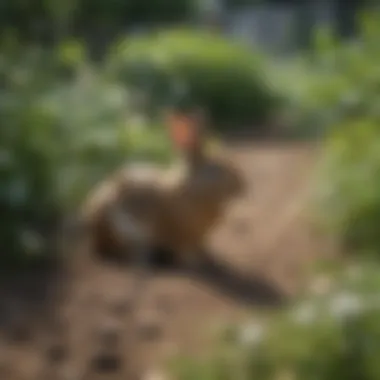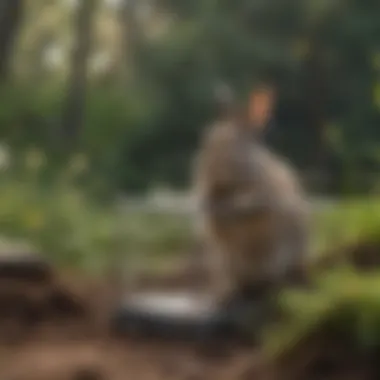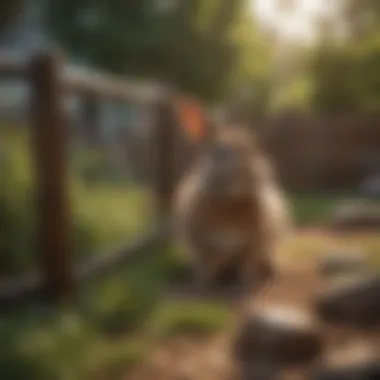Effective Strategies for Rabbit Control in Your Yard


Intro
Managing rabbit populations in residential areas is an issue many homeowners face. With their increasing numbers, these animals can become a nuisance, causing damage to gardens and landscapes. Understanding their behavior and habitat is essential for effective management. This article delves into various strategies homeowners can adopt to deal with rabbits, detailing humane removal methods and practical deterrents.
Fascinating Facts About the Animal
Unique Characteristics
Rabbits belong to the family Leporidae and are known for their long ears and powerful hind legs. With over 30 species worldwide, they adapt well to different environments. Their fur can vary in color, from gray to brown, which aids in camouflage. Rabbits are crepuscular, meaning they are most active during dawn and dusk.
Extraordinary Abilities
One of the notable abilities of rabbits is their impressive speed. They can reach up to 45 miles per hour in short bursts. This quickness helps them evade predators. Their large front teeth continually grow, necessitating the need to chew on various materials to keep them worn down. Also, rabbits have a unique digestive system that allows them to extract nutrients efficiently from fibrous plant material.
Behavior and Habitat
Natural Habitats
Rabbits are highly adaptable animals. Their natural habitats include forests, grasslands, and wetlands. In residential areas, they often seek shelter in dense shrubs or under decks and sheds. A homeowner's yard can inadvertently become a friendly environment for such creatures due to the availability of food and cover.
Social Structures
Rabbits are social animals that often form colonies. Within these colonies, they establish hierarchies and communicate through body language and vocalizations. They can be territorial as well, marking their presence with specific scents. Understanding their social behavior is key to addressing how they might invade a garden area.
Recent Scientific Discoveries
Latest Research Findings
Recent studies have shown that rabbit populations can impact local ecosystems. They tend to overgraze, affecting plant diversity. This behavior highlights the necessity for effective population management. Research into their reproduction patterns indicates that they can breed multiple times a year, leading to population booms in favorable conditions.
Breakthroughs in Animal Biology
Advancements in genetic research are shedding light on rabbit behaviors and their adaptability. Insights into their social interactions have also paved the way for better management practices. Understanding these biological aspects can aid in developing humane removal strategies.
Cultural Significance
Animals in Folklore
Throughout history, rabbits have held diverse roles in folklore and mythology. They often symbolize fertility and abundance due to their rapid reproduction. Various cultures have integrated them into tales, imparting lessons of cleverness and resourcefulness.
Influence on Art and Literature
Rabbits have consistently appeared in art and literature. From the well-known tales of Peter Rabbit to the symbolic use in various cultural motifs, these animals evoke curiosity and affection. Their influence is seen in various art forms, from paintings to animations, reflecting society's fascination with them.
The impact of rabbits extends beyond simple fascination; they inspire numerous narratives that shape cultural understanding.
Overall, comprehending the complexities of rabbit behaviors and their roles in ecosystems can help devise effective strategies for managing their populations in residential areas. This knowledge is particularly valuable for veterinarians, wildlife biologists, and families who seek solutions for maintaining their gardens while ensuring humane treatment of these animals.
Understanding Rabbit Behavior
Understanding the behavior of rabbits is essential for anyone dealing with their presence in a yard. Knowing how rabbits think and act can aid homeowners in creating strategies to discourage them from settling in their gardens. This section will outline key aspects of rabbit behavior, including their natural habitat, feeding habits, and breeding patterns. Understanding these elements allows for targeted and effective measures against rabbits.
The Natural Habitat of Rabbits
Rabbits are versatile creatures found in various environments. Their natural habitats typically include grassy fields, wooded areas, and meadows. They prefer environments where they can easily hide from predators and access food. In urban settings, rabbits often adapt to gardens and parks, as these areas provide ample food and shelter.
It is crucial to recognize that the presence of rabbits in your yard often signifies that the habitat meets their needs. Known for their burrowing behavior, rabbits create warrens for safety and nesting. Understanding this aspect can help homeowners determine why their property is appealing to these animals. Additionally, identifying the features of your yard that attract rabbits could lead to adjustments aimed at making the landscape less inviting.


Feeding Habits of Rabbits
Rabbits are herbivores, which means their diet consists solely of plant material. They usually feed on a variety of grasses, vegetables, and flowers. They are particularly fond of tender shoots and young plants. Understanding what attracts them to your yard can help in formulating effective deterrents.
Rabbits typically feed at dawn and dusk, taking advantage of low light conditions to minimize the risk of predation. Homeowners should inspect gardens during these times to observe rabbit activity. Also, it is beneficial to know that rabbits possess a unique digestive system, requiring them to eat large amounts of fibrous material to maintain health. This allows them to thrive in areas with abundant plant life.
Breeding Patterns and Population Growth
Rabbits breed rapidly, which contributes significantly to their populations in residential areas. A single pair can produce multiple litters each year, with each litter containing between three to twelve young. This high reproductive rate makes it essential for homeowners to act quickly when rabbit problems arise.
Breeding usually occurs in the spring and can continue throughout the warmer months. Each rabbit can begin breeding as early as three months old, further amplifying the population growth rate. This aspect of rabbit behavior underscores the importance of timely intervention when managing their populations, as ignoring the problem can lead to an overwhelming number of rabbits in a short period.
Key Takeaway: Understanding rabbit behavior—habitat, feeding habits, and breeding patterns—can inform effective strategies for managing their presence in your yard.
Identifying Rabbit Activity
Identifying rabbit activity is a crucial step in managing these animals effectively. Understanding how to spot the signs of their presence can help homeowners take appropriate action before the situation escalates. This section delves into the specific elements of rabbit activity, the benefits of timely identification, and the considerations one should be aware of when observing different indications of rabbit presence.
Signs of Rabbit Presence
Rabbits leave multiple signs that they have visited your yard. Recognizing these signs can save time and effort in control measures. Look for the following indicators:
- Droppings: Rabbit droppings are small, round, and usually dark. Finding them scattered in your garden can indicate their feeding habits.
- Tracks: Examine soft soil or snow for tracks. Rabbit footprints have a distinctive shape, often showing a pair of larger hind feet and smaller front paws.
- Gnaw marks: Check for fresh bite marks on your plants. Rabbits often chew on stems and bark. Their teeth can leave clean, sharp bites.
- Flattened areas: Rabbits often create resting spots by flattening grass or other ground cover, revealing their presence in a more subtle way.
Prompt identification of these signs enables homeowners to enact control measures promptly.
Analyzing Damage to Plants and Gardens
Understanding the type of damage caused by rabbits is essential for effectively directing management strategies. Typically, rabbits feed on tender, green plants. Here are some common ways to assess the damage:
- Observation: Regularly check your garden or landscaping for signs of nibbling. Tender shoots and flower petals are often preferred by rabbits, leaving a distinctive pattern of destruction.
- Type of plants: Rabbits tend to target certain species more than others. For example, leafy greens, such as lettuce and spinach, are often favored, while woody plants are less desirable.
- Crop loss: Pay attention to significant losses in your vegetable garden. A sudden drop in plant health or missing sections can indicate rabbit activity.
By analyzing the types of damage and understanding feeding habits, homeowners can make informed decisions about how to manage rabbit populations effectively.
A focused approach in identifying rabbit activity can lead to much more successful management strategies. Adopt a regular checking routine to stay ahead of potential infestations.
Preventative Measures
Preventative measures are essential for managing rabbit populations in residential areas. These strategies focus on proactive approaches that can minimize the likelihood of rabbits invading your yard. Implementing such measures reduces the need for reactive solutions later on, establishing a more sustainable relationship with wildlife.
Creating a Rabbit-Proof Garden
A rabbit-proof garden begins with understanding what attracts rabbits. They are drawn to specific plants, particularly young seedlings and tender foliage. To make your garden less appealing, consider using rabbit-resistant plants like lavender, sage, and marigolds.
- Design a diverse plant selection: Mixing up your garden with different types of plants can confuse rabbits. They prefer familiar environments with repetitive plantings.
- Raised beds: Elevating your garden beds can deter rabbits. The height makes it physically harder for them to access the plants.
- Mulching: Applying a thick layer of mulch, such as wood chips or pine needles, can create a barrier. This helps in limiting soft soil plants that rabbits prefer.
Using Fencing and Barriers
Fencing is one of the most effective physical barriers against rabbits. When done correctly, it can prevent them from entering your yard entirely.
- Height matters: A fence should be at least three feet high. Rabbits are strong jumpers, so your barrier needs to be robust.
- Bury the base: To stop rabbits from digging under the fence, bury it six to ten inches below ground level. This prevents them from creating tunnels to access the food.
- Materials: Use materials like chicken wire or hardware cloth. These provide visibility while ensuring they cannot sneak through.
Deterrents: Scents and Sounds
Rabbits are sensitive creatures. They rely heavily on their sense of smell. By using specific scents and sounds, you can effectively deter them without resorting to harm.
- Scent Deterrents: Sprinkling cayenne pepper or placing human hair around the garden can create an unpleasant environment for rabbits. They dislike strong smells that coincide with their predators.
- Sound Deterrents: Wind chimes or motion-activated noise makers can frighten rabbits and encourage them to find quieter locations.
- Alternative natural repellents: Products made from predator urine can be sprayed around the yard. The scent signals danger, prompting the rabbits to vacate the area.


Implementing these preventative measures provides homeowners with an effective strategy to manage rabbit populations while respecting local wildlife. Through understanding and adapting to rabbit behavior, gardens can remain thriving spaces.
Humane Removal Techniques
Humane removal techniques are crucial for managing rabbit populations while ensuring animal welfare. These methods prioritize the humane treatment of rabbits, allowing homeowners to address the presence of these animals without resorting to harmful practices. The importance of these techniques lies in balancing effective population control with ethical standards. Homeowners can contribute to local ecological balance by opting for humane approaches. Furthermore, employing these strategies helps to foster a positive public image about wildlife management efforts.
Live Traps: An Overview
Live traps are one of the most common humane methods for removing rabbits from residential properties. These traps are designed to capture rabbits without causing harm, allowing for safe relocation. Various models are available on the market, including the Havahart and Tomahawk brands, known for their effectiveness in this regard. The use of live traps is relatively straightforward:
- Setting the Trap: Place the trap in areas where rabbit activity has been observed. Baiting it with fresh vegetables, such as carrots or lettuce, increases the likelihood of capture.
- Monitoring the Trap: Check the trap regularly to ensure that captured rabbits are not left for extended periods, which can cause stress or harm.
- Handling the Captured Rabbit: When a rabbit is captured, approach the trap carefully to avoid startling the animal. Covering the trap with a cloth can help calm the rabbit prior to relocation.
Live traps come in various sizes, allowing homeowners to select a model that is suitable for their specific context. Moreover, using live traps aligns with broad wildlife management best practices, as it minimizes suffering and supports humane principles.
Relocation Considerations
Relocation of captured rabbits necessitates careful thought and planning. It is vital to ensure that any chosen relocation site is suitable for the rabbits’ needs. Here are several factors to consider:
- Distance from Original Location: Relocating rabbits too close to their original habitat can lead to returning or increased stress. A distance of at least several miles is recommended.
- Environmental Suitability: The new site should provide an appropriate habitat with ample food sources, shelter, and minimal competition from other wildlife.
- Legal Compliance: Check local regulations regarding wildlife relocation, as some areas may have specific laws governing the practice. It is essential to confirm that relocation complies with state and local wildlife laws to avoid legal issues.
Often, collaboration with local wildlife rehabilitators or animal control organizations may prove beneficial. They can offer guidance on suitable relocation sites and assist in ensuring that the process is ethically sound and legally compliant.
By taking humane approaches to wildlife management, we promote responsible coexistence with nature.
In summary, adopting humane removal techniques for rabbits not only addresses the issue of wildlife in your yard but also upholds ethical standards. Homeowners adopting these methods can effectively manage rabbit populations while promoting a healthy ecosystem.
Legal and Ethical Considerations
Understanding the legal and ethical dimensions of removing rabbits from your yard is essential. This section highlights important elements that homeowners must consider when managing rabbit populations. Effective rabbit removal does not only focus on getting rid of the animals but also ensures compliance with relevant laws and ethical practices. Addressing these aspects leads to more sustainable and responsible management of wildlife, which is beneficial for local ecosystems and community relationships.
Understanding Local Wildlife Laws
Local wildlife laws often dictate how residents can manage wildlife. These regulations may vary significantly from one region to another. Homeowners should familiarize themselves with these laws to avoid potential legal ramifications. In many areas, rabbits are protected under state or local wildlife protection laws, which can limit the options for removal or relocation.
Additionally, certain methods of removal, such as poisoning or trapping without a permit, may be illegal. Therefore, it is vital to check with local wildlife agencies or consult their official websites, such as en.wikipedia.org or britannica.com, to gain accurate information about the regulations in your area.
Residents should also consider the possibility of reporting rabbit populations to local wildlife management authorities. In some cases, they may offer assistance or guidance, ensuring compliant removal practices. This collaborative approach can foster better understanding and respect between homeowners and wildlife management bodies.
Ethical Practices in Wildlife Management
Adopting ethical practices in wildlife management is crucial for fostering a healthy ecosystem. Remove rabbits in a way that minimizes suffering and disruption to their natural behaviors. One widely accepted ethical approach is humane trapping, which allows for safe relocation without causing harm. It is important to select traps appropriately and to check them regularly, as prolonged captivity can induce significant stress and suffering in animals.
Moreover, education plays a key role in promoting ethical practices. Informing oneself about rabbit behavior and ecology can lead to more considerate management strategies. Simple actions, like maintaining a clean garden and using natural deterrents, can alleviate the need for removal altogether.
Responsible wildlife management balances human interests with animal welfare.
By addressing both legal and ethical considerations, homeowners can ensure that their actions are not only effective but also aligned with community standards and environmental stewardship.
Long-term Solutions for Yard Management
Managing rabbit populations in residential areas requires not just immediate solutions but also long-term strategies. These solutions focus on creating environments that are less inviting to rabbits while fostering healthy gardens. Homeowners should understand the significance of implementing long-term strategies, as they lead to sustainable management of yard spaces, minimizing conflicts with wildlife and enhancing the overall aesthetic of the garden.
Sustainable Gardening Practices
Sustainable gardening practices are critical in reducing rabbit attraction to your yard. These practices include:
- Choosing Native Plants: Native plants are adapted to your region and often require less maintenance. Avoid highly palatable plants, which include many garden favorites that rabbits adore.
- Implementing Companion Planting: Some plants can deter rabbits simply by their presence. For example, aromatic herbs like mint or rosemary can confuse and repel rabbits, while attracting beneficial insects.
- Usage of Organic Mulching: Wood chips or pine needles are good options. They not only suppress weeds but also reduce the chance for rabbits to burrow in the garden beds.


Practicing these techniques can cultivate a resilient garden ecosystem. It narrows the chances of rabbits fostering in your yard and promotes a healthier environment for other wildlife.
Engaging with Local Wildlife Control
Another essential aspect of long-term yard management is collaborating with local wildlife control agencies. This partnership can provide multiple benefits:
- Expert Insight: Local professionals can share knowledge about regional wildlife behavior and guidance tailored for managing rabbit populations. They can help identify potential habitats and effective strategies specific to your area.
- Assistance with Implementing Solutions: Many wildlife control services offer support in erecting fences or installing deterrents. Their experience ensures that solutions are effective and humane.
- Community Programs: Some areas may have community initiatives focused on wildlife management. Engaging in these programs can enhance your understanding of ecological balance and biodiversity.
By working closely with local professionals, homeowners can ensure they are not only solving the immediat need of removing rabbits but are also fostering an environment that encourages responsible coexistence with local wildlife.
Effective long-term solutions require a commitment from homeowners to understand and adapt to the behaviors of the rabbits in their neighborhoods.
Overall, adopting sustainable practices and collaborating with local wildlife authorities can significantly contribute to a well-managed yard, reducing the incidence of rabbit-related problems over time.
Community Awareness and Education
Community awareness and education play crucial roles in managing rabbit populations in residential areas. A well-informed community can foster effective communication and tactics surrounding wildlife interaction. Understanding the issues related to rabbits, their behaviors, and the potential impact on the ecosystem creates a ripple effect that benefits everyone.
Increased community knowledge leads to better practices regarding rabbits. When homeowners learn about the feeding habits and breeding patterns of rabbits, they can take proactive measures to deter them. Furthermore, public forums or workshops can be developed to address effective strategies for wildlife management. Sharing information through local events or social media enhances community engagement and collective responsibility.
Establishing a culture of responsible wildlife interaction helps reduce conflicts between rabbits and humans. Residents who are educated about how to manage their yards effectively will be less likely to experience damage or pest problems. These practices can lead to positive outcomes, such as healthier gardens and less stress for everyone.
“Education is the most powerful weapon which you can use to change the world.” — Nelson Mandela
Promoting Responsible Wildlife Interaction
Promoting responsible wildlife interaction is essential to maintaining balance in nature, particularly in populated areas. Homeowners should recognize the importance of coexistence with wildlife. This includes understanding that while rabbits might be seen as pests, they also contribute to the ecosystem.
Encouraging practices such as:
- Avoiding feeding rabbits intentionally, which can create dependency and overpopulation.
- Educating children about respecting wildlife and observing animals from a distance will promote a sense of responsibility.
- Advocating for natural controls, such as habitat preservation, which allows rabbits to thrive in their natural environments without encroaching on human spaces.
By fostering understanding in the community, homeowners will find themselves equipped to handle rabbit situations more effectively.
Collaborating with Neighbors
Collaboration with neighbors is an effective strategy for managing rabbit populations. When nearby homes work together, efforts can become more unified and impactful.
Sharing information between households can include:
- Joint efforts in fencing: Collaborating to build adequate fencing can provide a more extensive defense against rabbit invasions.
- Coordinated gardening practices: If multiple yards adopt similar rabbit deterrent methods, it reduces the food source and shelter available to the rabbits.
- Effective communication: Regularly discussing issues related to rabbits fosters a supportive environment where neighbors can share successful deterrents, such as using specific plants that repel rabbits.
Ultimately, collaborative efforts foster a sense of community while also providing a stronger means to address the rabbit situation. Neighbors uniting to address common issues can further strengthen their relationships and lead to better environmental management outcomes.
Ending
The importance of concluding effectively cannot be overstated in this discussion surrounding rabbit management strategies. Conclusively summarizing the key points allows readers to retain essential information and insights gleaned from this comprehensive guide. Homeowners dealing with troublesome rabbit populations gain clarity about implementing humane removal techniques and effective deterrents, contributing to a well-managed yard.
Effective rabbit management requires knowledge, planning, and commitment. By employing the summarized best practices and considering future measures, homeowners can create a suitable environment that deters these animals. Encouraging responsible and sustainable approaches to garden management not only benefits individual yards but also promotes ecological balance within the larger community.
“The best practice is to employ humane methods while respecting local wildlife laws.”
Summary of Best Practices
Summarizing the best practices in removing rabbits from your yard involves emphasizing several actionable steps that can be taken. Here are key recommendations:
- Implement Physical Barriers: Use sturdy fences that are at least two feet high and buried 6 to 12 inches underground to prevent digging.
- Choose Deer-Resistant Plants: Opt for plants that rabbits often avoid, such as lavender, marigold, and certain herbs. This minimizes the likelihood of attracting them to your garden.
- Utilize Deterrents: Employ sensors or devices that create noise or emit scents that rabbits find unpleasant, such as garlic or predator urine. This can disrupt their regular habits and encourage them to relocate.
- Monitor and Adjust: Regularly assess your yard for signs of rabbit activity. Adjusting strategies based on observed behavior can lead to increased effectiveness in repelling these animals.
- Community Engagement: Share these strategies with neighbors to create a unified approach to rabbit management in your area.
Future Considerations for Homeowners
Homeowners must remain proactive in their approach to long-term rabbit management. The following considerations are vital:
- Adaptation to Environmental Changes: As seasons change, rabbit behavior may also shift. Staying informed about these changes can aid in adjusting deterrents and barriers appropriately.
- Continuous Education: Engage with local wildlife management or veterinary experts to learn about best practices and any updates relevant to rabbit control.
- Evaluate the Impact of Climate Change: Changing climate conditions may influence rabbit habitats and behaviors, affecting how they interact with urban settings. Understanding these factors can inform future strategies.
- Participate in Community Initiatives: Local wildlife monitoring programs or community gardening initiatives can help promote responsible practices and synergize efforts among neighbors.
- Relocation vs. Coexistence: Continuously assess the ethical implications of methods employed, encouraging a balance between humane removal and coexistence whenever possible.
By synthesizing all the strategies presented in this article, homeowners can create a harmonious balance between maintaining their yards and respecting wildlife. The future of rabbit management hinges on these informed practices.







